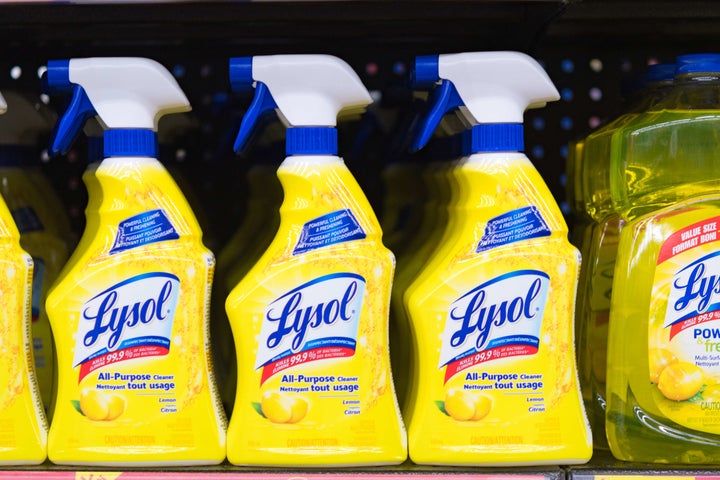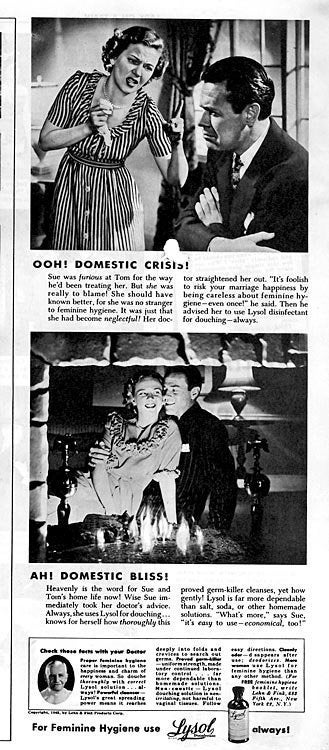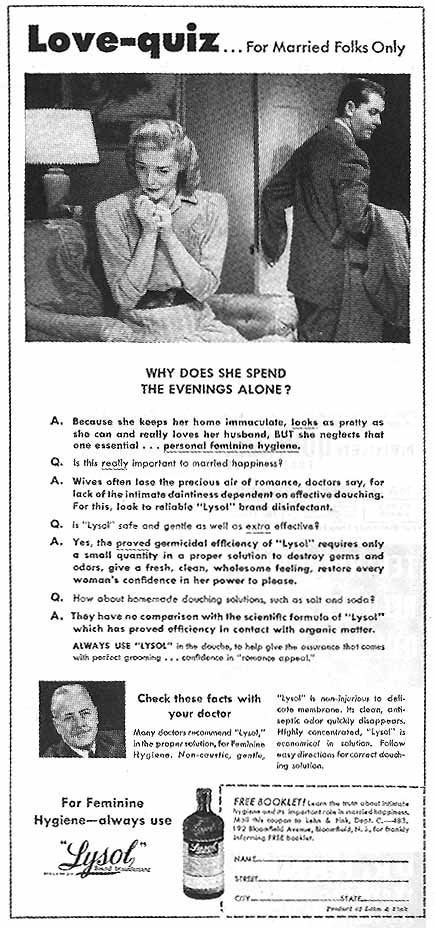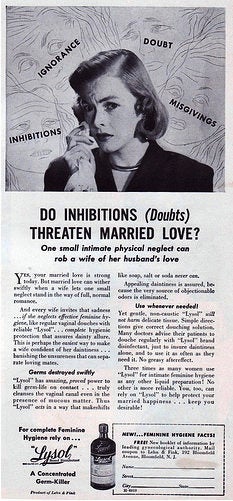
You might be knee-deep in Lysol wipes and sprays, but did you know that Lysol wasn’t always just a home cleaning brand?
Lysol manufacturer Lehn & Fink once marketed its antiseptic disinfectant as a vaginal douche, according to vintage advertisements from the early to mid-20th century.
Women, the ads suggest, were having marital problems because of feminine hygiene issues and genital odors that repulsed their husbands, and thus, they needed to clean themselves using Lysol.
![This ad tells women, "instead of blaming him if married love begins to cool, [a wife] should question herself."](https://img.huffingtonpost.com/asset/5ac3de042000007d06eb3c96.jpeg?cache=u4X0jpv7gA&ops=scalefit_720_noupscale)
But the full story is even wilder than that.
To back up a little, Lysol brand antiseptic disinfectant first appeared on the scene in 1889 as a way to help end a cholera epidemic in Germany. In 1918, ads touted it as an effective means to fight the flu virus during the influenza pandemic. Twelve years later, Lysol disinfectant liquid reached drug stores and hospitals, and in 1962, the company released an aerosol spray version.
In the 1920s, ads for Lysol as a feminine hygiene product started appearing in women’s magazines, encouraging housewives to wash their genitals with disinfectant liquid.
“A man marries a woman because he loves her. So instead of blaming him if married love begins to cool, she should question herself,” read one ad. “Is she truly trying to keep her husband and herself eager, happy married lovers? One most effective way to safeguard her dainty feminine allure is by practicing complete feminine hygiene as provided by vaginal douches with a scientifically correct preparation like ‘Lysol.’”
Clearly, Lysol’s ads spread a seriously antiquated and problematic viewpoint that a husband’s infidelity or dissatisfaction with a marriage could only be due to his wife’s failings ― like her odors or fertility.
As another ad reads, “Sue was furious at Tom for the way he’d been treating her. But she was really to blame! She should have known better, for she was no stranger to feminine hygiene. It was just that she had been neglectful!”

However, this call for douching was apparently code for something else as well: birth control.
In her 2001 book, Devices and Desires: A History of Contraceptives in America, historian Andrea Tone explains that feminine hygiene was a euphemism for contraception.
Those early Lysol ads included negative references to odors or germs, which referred to sperm, Tone wrote. So, keeping your body “germ-free” or maintaining your “dainty feminine allure” meant preventing pregnancy.
Tone’s findings are in line with the history of contraception in the U.S. In the early 20th century, birth control methods like condoms and diaphragms were costly and difficult to acquire.
This is at least in part due to the Comstock Act of 1873, a federal law that branded contraceptive devices or information as “obscene” and prohibited their distribution across state lines or via mail. Twenty-four states subsequently passed similar legislation to further restrict access and information to birth control.
As these laws effectively banned the selling and advertising of birth control, manufacturers marketed their contraceptive offerings as “feminine hygiene” products.

Postcoital douching became a popular method to prevent pregnancy. In fact, douching was the most common form of birth control from 1940 until the FDA approved the oral contraceptive pill in 1960. And between the 1930s and 1960s, the leading “feminine hygiene” product in the U.S. was ― you guessed it ― Lysol.
If the idea of cleaning your lady parts out with Lysol makes you cringe, you have the right instinct. Prior to a formula change in 1952, Lysol’s soap solution contained cresol, which Tone described as “a constituent of crude carbolic acid, a distillate of coal and wood” that, in high concentrations, could cause severe burning, inflammation and even death.
By 1911, doctors had recorded hundreds of Lysol-related deaths, including five from “uterine irrigation.”

Lehn & Fink was subject to a number of complaints and even lawsuits over Lysol’s use as a feminine hygiene product. In a 1935 lawsuit filed by a woman who experienced burns from Lysol douching, the company defended itself by stating that the burns must have been the result of “an allergy to Lysol.”
In 1961, a man complained to Lehn & Fink after a Lysol douche caused his wife’s vagina to blister and bleed. The company’s vice president responded by telling him that this report was “the first of its kind on record.”
Lehn & Fink also blatantly lied in the content of its feminine hygiene ads, many of which contained endorsements and testimonials from “eminent” physicians. An investigation by the American Medical Association found that these “experts” did not in fact exist.
To boot, Lysol wasn’t effective as contraception. In her book, Tone cited a 1933 study at Newark’s maternal health center that found that nearly half of the 507 women who used Lysol for birth control wound up pregnant.

In the 1960s and 1970s, “the pill” took the American contraceptive world by storm, and two major Supreme Court decisions improved access to birth control in the U.S.
In 1967, Sterling Drug acquired Lehn & Fink, and Lysol began its foray into bathroom cleaning with the launch of its toilet bowl cleaner in 1968. The brand has continued to focus on home cleaning and today is a product of Reckitt Benckiser.
In response to HuffPost’s inquiry about Lysol’s past use as a vaginal douching and contraceptive product, Reckitt Benckiser marketing director Rory Tait shared the following statement:
“For more than 100 years, Lysol has been dedicated to protecting families from the harmful consequences of germs – from cholera at the turn of the 20th century, to the flu virus in the present day. Like many consumer household brands, as knowledge of health and personal care evolved over the last century, so did the usage of Lysol. Lysol has evolved from a personal care and surface care brand to primarily a surface care brand, with Lysol cleansers, disinfectants and hand soaps being used widely in homes, schools and businesses around the world.”
Tait also encouraged consumers to read Lysol product labels carefully to learn about their intended uses.